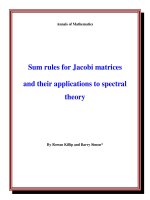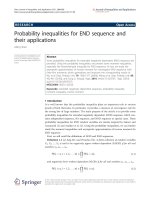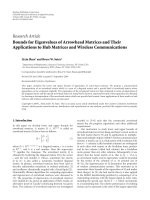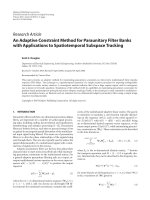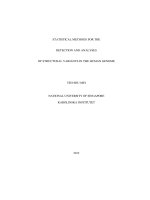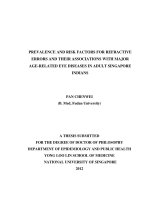Stochastic methods for bayesian filtering and their applications to multicamera multitarget tracking
Bạn đang xem bản rút gọn của tài liệu. Xem và tải ngay bản đầy đủ của tài liệu tại đây (1.38 MB, 173 trang )
STOCHASTIC METHODS FOR BAYESIAN
FILTERING AND THEIR APPLICATIONS TO
MULTICAMERA MULTITARGET
TRACKING
WANG YADONG
(B.ENG., M.ENG., NORTHWESTERN POLYTECHNICAL
UNIVERSITY, CHINA)
A THESIS SUBMITTED
FOR THE DEGREE OF DOCTOR OF PHILOSOPHY
DEPARTMENT OF ELECTRICAL AND COMPUTER
ENGINEERING
NATIONAL UNIVERSITY OF SINGAPORE
2007
To Zhang Tianxia
Acknowledgements
First of all, I would like to thank my supervisors, Dr. Wu Jiankang and Professor
Ashraf A. Kassim, for invaluable guidance, inspiring discussions and support during
my Ph.D. study.
I gratefully acknowledge the financial support for my Ph.D. study given by both
National University of Singapore and Institute for Infocomm Research, Singapore.
I also thank Dr. Huang Weimin and Mr. Pham Nam Trung for their helps and
discussions. I wish to thank Dr. N. de Freitas for providing the programs of particle
filters on his webpage, Dr. Ronald P.S. Mahler for his literature and Dr. Ba-Ngu
Vo for the programs of the probability hypothesis density filter.
Finally, I would like to thank my parents and brother for support during these
years and my wife Tianxia for love and encouragement.
Wang Yadong
July 2007
iii
Contents
Acknowledgements iii
Summary viii
List of Tables xi
List of Figures xii
1 Introduction 1
1.1 Motivations . . . . . . . . . . . . . . . . . . . . . . . . . . . . . . . 4
1.2 Objective of this study . . . . . . . . . . . . . . . . . . . . . . . . . 9
1.3 Contributions . . . . . . . . . . . . . . . . . . . . . . . . . . . . . . 10
1.4 Organization of the thesis . . . . . . . . . . . . . . . . . . . . . . . 11
2 Literature review 12
2.1 Bayesian filtering framework . . . . . . . . . . . . . . . . . . . . . . 13
iv
CONTENTS v
2.2 Filtering methods . . . . . . . . . . . . . . . . . . . . . . . . . . . . 16
2.3 Likelihood functions for visual tracking . . . . . . . . . . . . . . . . 22
2.4 Multicamera tracking methods . . . . . . . . . . . . . . . . . . . . . 24
2.5 Multitarget tracking methods . . . . . . . . . . . . . . . . . . . . . 25
2.6 Summary . . . . . . . . . . . . . . . . . . . . . . . . . . . . . . . . 29
3 Adaptive particle filter for tracking 30
3.1 Introduction . . . . . . . . . . . . . . . . . . . . . . . . . . . . . . . 30
3.2 Spatio-temporal recursive Bayesian filter . . . . . . . . . . . . . . . 32
3.3 Particle filter . . . . . . . . . . . . . . . . . . . . . . . . . . . . . . 35
3.3.1 Importance sampling . . . . . . . . . . . . . . . . . . . . . 36
3.3.2 Resampling . . . . . . . . . . . . . . . . . . . . . . . . . . . 38
3.3.3 Generic particle filter . . . . . . . . . . . . . . . . . . . . . 40
3.4 Adaptive mixed particle filter for multicamera tracking . . . . . . . 42
3.4.1 Algorithm overview . . . . . . . . . . . . . . . . . . . . . . 42
3.4.2 Object segmentation . . . . . . . . . . . . . . . . . . . . . . 43
3.4.3 Likelihood function . . . . . . . . . . . . . . . . . . . . . . 44
3.4.4 Mixed importance sampling . . . . . . . . . . . . . . . . . . 45
3.4.5 Weight function of particle filter . . . . . . . . . . . . . . . 47
3.4.6 Adaptive importance sampling . . . . . . . . . . . . . . . . 48
CONTENTS vi
3.4.7 Algorithm summary . . . . . . . . . . . . . . . . . . . . . . 51
3.5 Experimental results . . . . . . . . . . . . . . . . . . . . . . . . . . 53
3.6 Discussions . . . . . . . . . . . . . . . . . . . . . . . . . . . . . . . 61
3.6.1 Target size . . . . . . . . . . . . . . . . . . . . . . . . . . . . 61
3.6.2 Comparison with other multicamera tracking methods . . . 61
3.6.3 Adaptive mixed weights for importance sampling . . . . . . 62
3.7 Summary . . . . . . . . . . . . . . . . . . . . . . . . . . . . . . . . 64
4 The PHD filter for visual tracking 65
4.1 Introduction . . . . . . . . . . . . . . . . . . . . . . . . . . . . . . . 65
4.2 Detecting foreground people . . . . . . . . . . . . . . . . . . . . . . 70
4.3 Tracking model . . . . . . . . . . . . . . . . . . . . . . . . . . . . . 73
4.4 Finite set statistics . . . . . . . . . . . . . . . . . . . . . . . . . . . 74
4.4.1 Random state sets and random measurement sets . . . . . . 76
4.4.2 Belief-mass functions and multitarget integro-differential cal-
culus . . . . . . . . . . . . . . . . . . . . . . . . . . . . . . 77
4.4.3 Multisensor multitarget Bayesian modelling . . . . . . . . . 80
4.4.4 Unified fusion of multisource-multitarget information . . . . 81
4.4.5 Probability generating functionals and functional derivatives 83
4.5 Probability hypothesis density . . . . . . . . . . . . . . . . . . . . . 85
CONTENTS vii
4.6 Particle PHD filter . . . . . . . . . . . . . . . . . . . . . . . . . . . 89
4.7 Data-driven particle PHD filter . . . . . . . . . . . . . . . . . . . . 92
4.7.1 Sequential importance sampling . . . . . . . . . . . . . . . 93
4.7.2 Optimal importance function . . . . . . . . . . . . . . . . . 94
4.7.3 Importance function for survival targets . . . . . . . . . . . 97
4.7.4 Importance function for spontaneous birth targets . . . . . 103
4.7.5 Data-driven particle PHD filter . . . . . . . . . . . . . . . . 104
4.8 Gaussian mixture PHD filter . . . . . . . . . . . . . . . . . . . . . 107
4.8.1 Basic Gaussian mixture PHD filter . . . . . . . . . . . . . . 107
4.8.2 Scene-driven method for new-birth objects . . . . . . . . . . 111
4.9 Results . . . . . . . . . . . . . . . . . . . . . . . . . . . . . . . . . . 112
4.9.1 Particle PHD filter . . . . . . . . . . . . . . . . . . . . . . . 112
4.9.2 Data-driven PHD filter . . . . . . . . . . . . . . . . . . . . . 117
4.9.3 Gaussian mixture PHD filter . . . . . . . . . . . . . . . . . . 124
4.10 Discussion . . . . . . . . . . . . . . . . . . . . . . . . . . . . . . . . 130
4.11 Summary . . . . . . . . . . . . . . . . . . . . . . . . . . . . . . . . 132
5 Conclusion and future work 134
Bibliography 140
Summary
Target tracking is an important key technology for many military and commercial
applications. The tracking problems are usually formulated by using the state space
approach for discrete-time dynamic systems. Under this framework, the tracking
is to estimate the state x
t
of target at time t, given the measurement sequence y
1:t
of sensor from time 1 to t, or equivalently to construct the conditional probability
density function p(x
t
|y
1:t
). The theoretical optimal solution is provided by the
recursive Bayesian filter. However, for multi-sensor multi-target tracking, there
are many challenges to extend the single-sensor single-target Bayesian filter. In
this thesis, the focus is on extending the Bayesian filter to multi-camera or multi-
target visual tracking.
First, a spatio-temporal recursive Bayesian filter is formulated for tracking a target
using multiple cameras. We propose an adaptive mixed particle filter for the imple-
mentation of the spatio-temporal recursive Bayesian filter for the dynamic system.
viii
Summary ix
In particular, the mixed importance sampling strategy is used to fuse temporal in-
formation of dynamic systems and spatial information from multiple cameras. It
is adaptive in sense that it automatically ranks data from multiple cameras and
assigns weights according to data’s quality in the fusion process. The results show
that this method is able to recover a target’s position even when it is completely
occluded in a particular camera for some time.
Second, a multi-target Bayesian filter, the probability hypothesis density (PHD)
filter, is designed to track unknown and variable number of targets in image se-
quences. Because the dimensions of state and observation are time-varying during
the tracking process, the PHD filter employs the random finite set representation of
multiple states and multiple measurements and the PHD is the 1st order moment
of random finite set. The PHD filter is implemented using two methods: both
particle filter and Gaussian mixture. For the particle PHD filter, two importance
functions and correspondent weight functions are proposed for survival targets
and new-birth targets, respectively. It is shown in the thesis that the importance
function for survival targets theoretically extends the optimal importance function
of the linear Gaussian model from single-measurement case to measurement-set
(multi-measurement) case. Whereas the importance function for new-birth targets
is a data-driven method which uses the current measurements in the sampling
process of the particle PHD filter. For the Gaussian mixture PHD filter, a scene-
driven method which incorporates the prior knowledge of scene into the PHD filter
Summary x
is presented. The results show that these PHD filters are able to track a variable
number of targets and derive their positions in image sequences.
This work suggests that stochastic methods for Bayesian filtering are powerful
means for multi-sensor multi-target tracking.
List of Tables
4.1 Single-target versus multi-target statistics . . . . . . . . . . . . . . 75
4.2 Parameter list of the particle PHD filter . . . . . . . . . . . . . . . 113
4.3 Comparison between the GMPHD filter and the particle PHD filter 130
xi
List of Figures
2.1 Overview of target tracking methods. . . . . . . . . . . . . . . . . . 13
3.1 Sequential importance sampling algorithm . . . . . . . . . . . . . . 37
3.2 Resampling algorithm . . . . . . . . . . . . . . . . . . . . . . . . . 39
3.3 Generic particle filter . . . . . . . . . . . . . . . . . . . . . . . . . . 41
3.4 Adaptive mixed importance sampling. . . . . . . . . . . . . . . . . 46
3.5 An example of the adaptive mixed importance sampling . . . . . . 51
3.6 Tracking results using the mean shift algorithm . . . . . . . . . . . 54
3.7 Tracking results using the condensation algorithm . . . . . . . . . . 56
3.8 Tracking results using the adaptive particle filter . . . . . . . . . . . 57
3.9 An example of dynamically allocated sample numbers . . . . . . . . 58
3.10 Tracking results using the condensation algorithm and the adaptive
particle filter . . . . . . . . . . . . . . . . . . . . . . . . . . . . . . 60
3.11 Comparison for the effective sample sizes . . . . . . . . . . . . . . . 63
xii
LIST OF FIGURES xiii
4.1 PHD visual tracking implementation. . . . . . . . . . . . . . . . . . 69
4.2 Gate technology . . . . . . . . . . . . . . . . . . . . . . . . . . . . . 98
4.3 Scene-driven method . . . . . . . . . . . . . . . . . . . . . . . . . . 112
4.4 Detection results of adaptive background subtraction for video On-
eStopMoveEnter1front . . . . . . . . . . . . . . . . . . . . . . . . . 114
4.5 Tracking results of the particle PHD filter for video OneStopMoveEn-
ter1front . . . . . . . . . . . . . . . . . . . . . . . . . . . . . . . . . 115
4.6 Tracking result of the particle PHD filter for the number of targets 116
4.7 Detection results for video OneStopMoveEnter1front. . . . . . . . . 119
4.8 Tracking results of the data-driven particle PHD filter for video On-
eStopMoveEnter1front . . . . . . . . . . . . . . . . . . . . . . . . . 120
4.9 Detection results for video Meet Split 3rdGuy . . . . . . . . . . . . 121
4.10 Tracking results of the data-driven particle PHD filter for video
Meet Split 3rdGuy . . . . . . . . . . . . . . . . . . . . . . . . . . . 122
4.11 Tracking results of the particle PHD filter for video Meet Split 3rdGuy 123
4.12 Tracking result of the GMPHD filter for video OneStopMoveEn-
ter1front . . . . . . . . . . . . . . . . . . . . . . . . . . . . . . . . . 125
4.13 Comparison of the GMPHD filter and the particle PHD filter . . . . 127
4.14 Absolute error in estimates of target number . . . . . . . . . . . . . 128
LIST OF FIGURES xiv
4.15 Wasserstein distance. . . . . . . . . . . . . . . . . . . . . . . . . . . 129
Chapter 1
Introduction
Target tracking is a fundamental problem for many military and commercial appli-
cations such as battlefield monitoring, video surveillance, human motion analysis,
and human-computer interface. Different applications have different scenarios and
motivations. For example, in radar tracking for battlefield monitoring, the target
(e.g., airplane, missile, or ship) usually appears as a spot on the radar screen with
complex maneuvers such as acceleration, turns, or stops. Whereas in visual track-
ing for video surveillance, the target (e.g., person or vehicle) is usually captured
in form of image sequences. Rich information such as intensity, color, or contour
contained in target pictures can be used for distinguishing, tracking and other form
of analysis.
The tracking problems are usually formulated by using the state space approach for
1
CHAPTER 1. INTRODUCTION 2
discrete-time dynamic systems. Under this framework, the tracking is to estimate
the state of target x
t
(e.g., position, velocity, and identification) at time t given the
measurement sequence of sensor y
1:t
(e.g., image sequences captured by a camera)
from time 1 to t, or equivalently to construct the conditional probability density
function p(x
t
|y
1:t
). Successive estimates provide the track which describes the
trajectory of a target.
A simple form of tracking is tracking a single target. There are two main groups
of methods for tracking a single target: filtering methods and likelihood functions.
Filtering methods are mostly used in radar tracking and generally used to capture
the dynamics of targets. The commonly used methods include: i) Kalman filter
for linear system and Gaussian noise [68] and its extensions such as the extended
Kalman filter (EKF) [45, 5] and the unscented Kalman filter (UKF) [67]; ii) in-
teracting multiple models (IMM) for multiple motion models [20]; and iii) particle
filters for nonlinear and non-Gaussian problems [51, 39]. On another hand, like-
lihood functions are mostly used in visual tracking tasks and concentrate on how
to differentiate the target from the background. The typical likelihood functions
include intensity-based method [81], contour-based method [62], and color-based
method [32].
As tracking a single target using one sensor has many limitations, there is a recent
trends towards multi-sensor or multi-target tracking. There has been some research
done on tracking using multiple cameras [21, 78, 90, 97] and on tracking multiple
CHAPTER 1. INTRODUCTION 3
targets [43, 107, 101, 36].
When tracking multiple targets, data association methods are generally used to as-
sociate observations of sensors with targets. For example, if there are two targets, a
person and a car, and the camera detects three foreground blobs, data association
must determine which blob belongs to the person, the car, or the clutter environ-
ment, i.e., there are multiple choices for association. The aim of data association
is to find the best association scheme. There have been a few categories of data
association methods: i) joint probabilistic data association (JPDA) [43] which uses
the weighted average of functions of multiple observations to update the state of
a target, ii) multiple hypotheses tracking (MHT) [107] which enumerates multiple
possible association hypotheses during a period till one hypothesis can be veri-
fied, and iii) assignment algorithms [101, 36] which essentially perform constrained
optimization problems to find an optimal association solution.
Another trend for tracking multiple targets is tracking a variable number of targets.
When the target number is unknown and variable, data association must deal with
the variable dimension of state or observation. Some methods have been proposed
to overcome this difficulty: jump-diffusion process [89], reversible jump Markov
chain Monte Carlo method (RJMCMC) [72], and finite set statistics (FISST) and
probability hypothesis density (PHD) [49, 85].
CHAPTER 1. INTRODUCTION 4
1.1 Motivations
Two stochastic methods for Bayesian filtering are closely related to this thesis,
particle filter and probability hypothesis density.
The particle filter, also called sequential Monte Carlo method, is a Monte Carlo sim-
ulation based method and can be applied to nonlinear or non-Gaussian problems.
The particle filter consists of 2 basic parts: importance sampling and resamping.
Gordon et al. proposed the first particle filter, the bootstrap algorithm [51]. Liu
and Chen presented a general framework for applying Monte Carlo methods to dy-
namic systems [80]. Their framework includes importance sampling, resampling,
rejection sampling, and Markov chain iterations. Doucet et al. provided a Bayesian
filtering framework of sequential simulation based methods for nonlinear and non-
Gaussian dynamic models [41]. Their other major contributions are summarizing
the methods for selecting importance sampling functions.
Much work has been done on tracking a visual target using particle filters. Isard and
Blake proposed the first particle filter based visual tracking algorithm, the conden-
sation (CONditional DENSity propogATION) algorithm [62], and later combined
it with the statistical technique of importance sampling [63]. They demonstrated
their method using a hand tracker which combines color blob-tracking with a con-
tour model.
There has some research on tracking multiple targets using particle filters. Isard
CHAPTER 1. INTRODUCTION 5
and MacCormick presented a Bayesian multiple-blob tracker, BraMBle [64], to
track multiple persons using a particle filter. Vermaak et al. [121] introduced a
mixed particle filter to model each component (mode or target) with an individual
particle filter and form part of the mixture. Okuma et al. [98] combined Vermaak’s
method with the Adaboost algorithm [123] to track multiple hockey players.
While considerable work involving the particle filter has been done on tracking,
there has not been much work on multicamera tracking using particle filters. Oc-
clusion, especially long-time complete occlusion, is a serious problem for tracking
using a single camera. Multiple cameras provide information of a moving target
from multiple views. As such, occlusions do not occur in all cameras and fusion
of data from multiple cameras enables tracking of a moving target with desirable
performance. Both importance sampling and resampling strategies in particle fil-
ters provide a theoretical framework for information fusion of multiple cameras.
Therefore, how to design adaptive particle filter to fuse information of multiple
cameras remains a challenge.
Tracking becomes challenging when the number of targets is unknown and variable
because the state and observation dimensions are time-varying under this situation.
There has been some recent work that attempt to meet this challenge. Reid pro-
posed multiple hypothesis tracking (MHT) algorithm which enumerates multiple
track-to-measurement association hypotheses during a period till one hypothesis
can be verified [107]. The problem of MHT is the potential combinatorial explosion
CHAPTER 1. INTRODUCTION 6
in the number of hypotheses. Miller et al. generated the conditional mean esti-
mates of an unknown number of targets and target types via jump-diffusion process
[89]. Musicki et al. proposed integrated probabilistic data association (IPDA) [95]
as a recursive formula for both data association and probability of target existence.
Vermaak et al. presented the existence joint probabilistic data association filter (E-
JUDAH) to track a variable number of targets [122]. E-JUDAH associates with
each target a binary existence variable that indicates whether the correspondent
target is active or not and assumes that a large and fixed target number (including
both active and inactive targets) is known in advance. Green proposed a reversible
jump Markov chain Monte Carlo (RJMCMC) approach [52] to generate samples
with different dimensions by ”jump” operations in a Markov chain. Khan et al.
used this method to track a variable number of interacting ants [71]. Smith et al.
used RJMCMC to track varying numbers of interacting people [114]. To simplify
the sampling procedure for “jump”, [71] and [114] restrict proposals of RJMCMC
to add or remove a single target. Mori and Chong gave a point process formalism
for multitarget tracking problems [93].
The FInite Set STatistics (FISST) proposed by Mahler is the first systematic treat-
ment of multisensor-multitarget tracking. FISST results in a systematic Bayesian
unification of detection, classification, tracking, decision-making, sensor manage-
ment, group-target processing, expert-systems theory and performance evaluation
in multiplatform, multisource, multievidence, multitarget, multigroup problems
CHAPTER 1. INTRODUCTION 7
[49, 83]. The problem of FISST is its computational complexity when dealing with
multiple sensors and multiple targets. To reduce the complexity, Mahler devised
the Probability Hypothesis Density (PHD) filter as an approximation of multitar-
get filter [85]. There are two implementation methods for the PHD filter. One is
particle filter implemented by Zajic [131], Sidenbladh [112] and Vo et al. [125]. Jo-
hansen et al. [66] and Clark and Bell [28] demonstrated the convergence property of
the particle PHD filter respectively, which show that the empirical representation
of the PHD converges to the true PHD. The other is Gaussian mixture proposed
by Vo and Ma [124]. Clark and Vo [27] proved the convergence property of the
Gaussian mixture PHD filter.
The particle PHD filter differs from the other particle filters. There has been much
work on tracking multiple targets using particle filters. These works can mainly
be divided into two categories: 1) one particle filter with the joint state space for
multiple targets [60, 64, 72]; 2) one mixed particle filter, where each component
(mode or cluster) is modelled with one individual particle filter that forms part of
the mixture [121, 98]. The disadvantage of the 1st approach is that it is difficult
to find an efficient importance sampling function when the target number is large
and the dimension of the joint state space is high. The 2nd approach usually uses
some heuristic methods to determine the target number firstly and then derives
states of targets. For example, the boosted particle filter [98] adds, deletes, and
merges targets according to the overlapping regions between the targets detected
CHAPTER 1. INTRODUCTION 8
by Adaboost algorithm and the existing targets (from the authors’ programs [3]).
The particle PHD filter is similar with the second approach but the particle PHD
filter has an important property that the integral of the PHD over a region in a
state space is the expected number of targets within this region. The PHD filter
can automatically determine the target number by this property, which differs from
the other multitarget particle filters.
There have been some applications of FISST and PHD. Sidenbladh tracked ve-
hicles in terrain using the FISST particle filtering [113]. Tobias and Lanterman
[118] applied the particle PHD filter for radar tracking problem. Clark and Bell
[29] used the particle PHD filter in tracking in sonar images. Ikoma et al. filtered
trajectories of feature points in images using the particle PHD filter [61]. Haworth
et al. presented a system to detect and track metallic objects concealed on people
in sequences of millimeter-wave images [55]. Clark et al. developed the Gaus-
sian mixture PHD multitarget tracker [25] and demonstrated it on forward-looking
sonar data [28]. While tracking people has wide applications and no work has been
done on automatically tracking people or human groups using the PHD filter.
Some applications in business intelligence such as customer statistics only care
about the number of people or groups near a store and do not need the identification
information of them. The PHD filter is suitable for these scenarios. Under these
cases, the current measurements for the PHD filter are not a single measurement
but a random measurement set. Therefore, how to design importance function
CHAPTER 1. INTRODUCTION 9
of the particle PHD filter to incorporate the current measurement set remains a
challenge.
1.2 Objective of this study
The goal of this thesis is to extend mathematical methods of stochastic processes,
especially Bayesian filtering, to visual tracking problems. Two new developments
of Bayesian filtering, the particle filter and the probability hypothesis density filter,
are chosen them as our theoretical methods. The tracking scenarios are:
• The use of multiple cameras to track a target is investigated to deal with long-
time full occlusion in a particular camera. The two cameras have a common
overlapping field of view in the experiments. The target may be occluded by
the environment such as tree or building in one camera while it can be seen
by another camera. A spatio-temporal Bayesian filtering is designed to fuse
the spatial information from both cameras and the temporal information of
dynamic system. The spatio-temporal Bayesian filtering may be nonlinear
and non-Gaussian, so it is implemented using an adaptive particle filter which
can automatically rank data from two cameras and assigns weights according
to the quality of data in the fusion process.
• When the number of targets are unknown and time-varying, the dimensions of
CHAPTER 1. INTRODUCTION 10
state and measurement of dynamic system are variable. Tracking pedestrians
in a corridor of a shopping center is an example. To deal with this problem,
tracking a variable number of people in image sequences using the probability
hypothesis density filter is investigated. When people appear, merge, split,
and disappear in the field of view of a camera, the aim is to track the time-
varying number of targets and their position.
1.3 Contributions
The contributions of this thesis are summarized as below:
• A data fusion approach is proposed for visual tracking using multiple cameras
with overlapping fields of view. A spatio-temporal recursive Bayesian filter
is designed to fuse spatial information from multiple cameras and temporal
information of dynamic systems. An adaptive mixed particle filter is for-
mulated to realize the spatio-temporal recursive Bayesian filter. The mixed
particle filter adapts to the dynamic change of data quality of two cameras.
The algorithm can recover the target’s position even under long-time com-
plete occlusion in a camera.
• A multitarget recursive Bayesian filter, the Probability Hypothesis Density
(PHD) filter, is applied to a visual tracking problem: tracking a variable
number of people or human groups in image sequences. The PHD filter
CHAPTER 1. INTRODUCTION 11
is implemented using two methods: both sequential Monte Carlo method
and Gaussian mixture. Two importance functions and weight functions of
the particle PHD filter are developed. The importance function for survival
targets theoretically extends the optimal importance function of the linear
Gaussian model from single-measurement case to measurement-set (multi-
measurement) case. Whereas the importance function for spontaneous birth
targets is a data-driven method for spontaneous birth objects. A scene-
driven method is also proposed to initialize the Gaussian mixture probability
hypothesis density filter and model the birth of new objects. The results
show when people or groups appear, merge, split, and disappear in the field
of view, these PHD filters can track the variable number of objects and their
positions.
1.4 Organization of the thesis
This thesis is organized as follows. Chapter 2 provides a literature review for
target tracking. Chapter 3 presents an adaptive mixed particle filter for tracking
and data fusion of multiple cameras. Tracking a variable number of pedestrians or
human groups in image sequences using the probability hypothesis density filter is
introduced in chapter 4. Chapter 5 concludes this thesis and provides the future
work.
